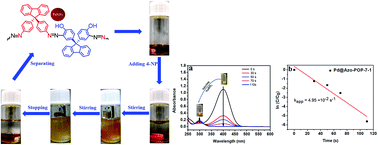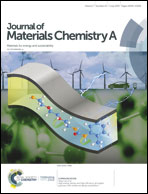A soluble porous organic polymer for highly efficient organic-aqueous biphasic catalysis and convenient reuse of catalysts†
Abstract
Functional porous organic polymers (POPs) such as PIM-1 with good solubility have been used for the homogenization of heterogeneous catalysts very recently, in addition to the traditional gas/liquid adsorption and separation. As emerging functional POPs, Azo-POPs have been studied broadly, although they are usually insoluble. This paper reports a novel soluble Azo-POP (named Azo-POP-7) with a fluorene-derived β-hydroxy-azobenzene subunit in the polymer main chain for the first time via a facile azo-coupling polymerization of contorted monomers. The resultant polymers exhibited a Brunauer–Emmett–Teller (BET) specific surface area of 364 m2 g−1 and good solubility in most organic solvents. Moreover, the soluble catalyst Pd@Azo-POP-7 showed the highest efficiency (kapp = 4.95 × 10−2 s−1) for the organic-aqueous biphasic reduction reaction of 4-nitrophenol with good recyclability (12 cycles). This work introduces a novel strategy for designing novel functional POPs for organic/aqueous biphasic catalysis.



 Please wait while we load your content...
Please wait while we load your content...